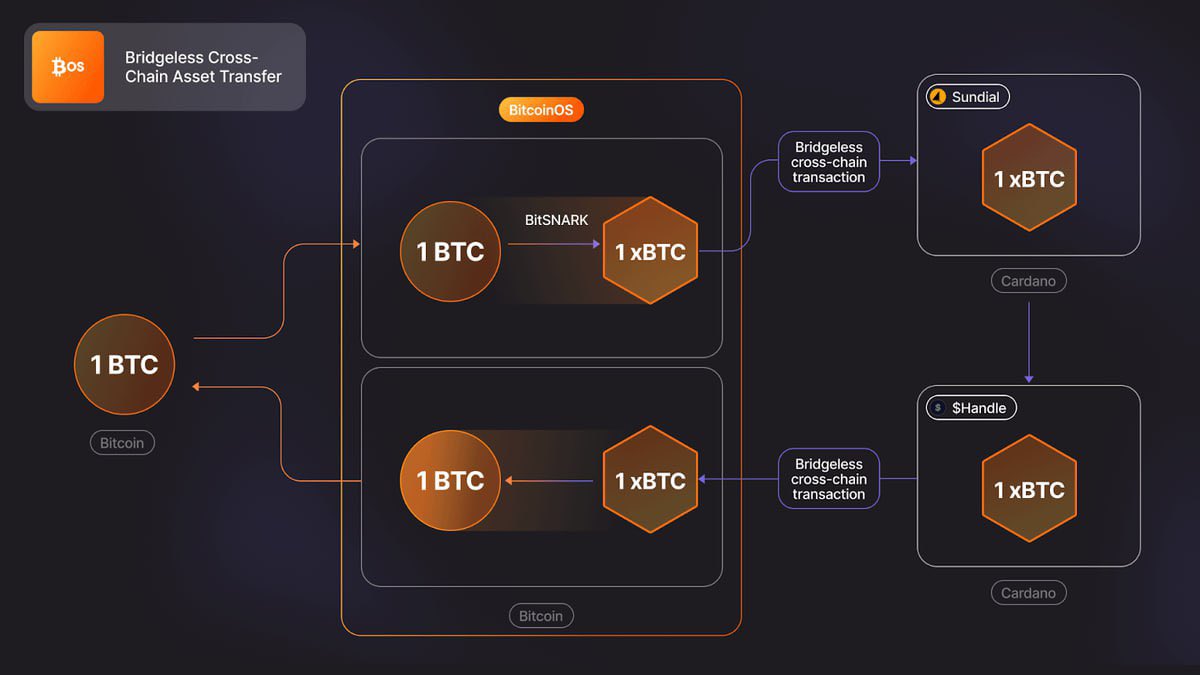Recently, I have been paying attention to the #BTCFi field, especially in this cycle where BTC has performed exceptionally well, and the development momentum of the related ecosystem is very strong. The market is clearly leaning towards projects with actual technical support, and @BTC_OS is one that I have on my watchlist. Let me elaborate a bit on my understanding of BitcoinOS.
In July 2024, BitcoinOS completed zero-knowledge proof (ZKP) verification on the BTC mainnet, and ZKP technology can verify transactions without revealing data, which is significant for enhancing privacy and efficiency. It has also successfully run directly on the BTC mainnet, showcasing its high technical value.
By May 2025, they launched a bridge-less cross-chain technology, achieving seamless asset transfer from BTC to Cardano. Traditional cross-chain bridges often have security vulnerabilities, and BitcoinOS has circumvented these risks with a "bridgeless" solution, marking a technical breakthrough. This truly interconnects $BTC and $ADA, and if I remember correctly, it should be one of the earlier implementations of introducing BTC into the Cardano protocol.
Essentially, the core goal of BitcoinOS is to make BTC more "versatile." Through their technology, BTC can not only continue to serve as "digital gold" but also support complex smart contracts, DApps, and even seamlessly integrate with the functionalities of other public chains, all while inheriting BTC's decentralization and security throughout.
For example, their system allows developers to build DeFi protocols similar to ETH on BTC, or staking mechanisms like those on Cardano, without worrying about the limitations of the BTC network itself. This essentially expands the application scenarios of BTC, pushing it from a singular value storage to a universal settlement and application layer.
Their strategy also differs significantly from the current BTC layer two networks; they are not building a new chain but directly "leveraging" the existing ecosystem. BitcoinOS connects the ecosystems and users of mature chains like Arbitrum, Cardano, Sovryn, and B² Network to BTC through their tech stack.
This "connector" role is somewhat like a "hub" in the crypto world, attracting traffic and developers from other chains while also benefiting the BTC ecosystem. For instance, the collaboration with Arbitrum combines the high throughput of Ethereum L2 with the security of BTC, while the linkage with Cardano brings ADA community's DeFi and NFT players into the BTC ecosystem. This multi-chain collaborative approach theoretically can significantly enhance BTC's network effects.
The $BOS token is the core of the entire system, designed as a "chain-less" token that can flow freely across multiple chains. Its significance goes beyond cross-chain transfers; it attempts to solve the security issues of traditional bridges (like those past incidents where bridges were hacked for hundreds of millions). $BOS acts as a "pass" for the ecosystem, allowing developers to pay gas fees, DApps to use it for incentives, and users to interact across chains. More importantly, the operation of $BOS is entirely reliant on BTC's security model, which fundamentally distinguishes it from other cross-chain tokens.
In addition to technology, BitcoinOS's ecological layout is also worth noting. The announced collaborations with Arbitrum, Cardano, Sovryn, etc., are continuously expanding their partner network. This includes focusing on cross-chain infrastructure, expanding BTC, and MODE providing fast settlement, all of which contribute to the BTCFi ecosystem. If they can attract more heavyweight players in the future (like a few more top public chains or DeFi protocols), BitcoinOS's "hub" position will be even more solid.
Of course, the project is still in its early stages, and after the technology is implemented, we need to observe the actual developer adoption rate and user activity. Although the direction for expanding the BTC ecosystem is clear, the competition is also fierce, with old players like Stacks and Rootstock also making strides in BTCFi. However, BitcoinOS's technical path and ecological strategy indeed have unique aspects, especially with its first-mover advantage in ZKP and bridge-less cross-chain technology.
Overall, BitcoinOS's technology and positioning have certain potential in the BTCFi track, especially as the BTC ecosystem transitions from "storage" to "application." I hope it can make BTC a universal foundational layer in the crypto world, and those interested can learn more about it.

免责声明:本文章仅代表作者个人观点,不代表本平台的立场和观点。本文章仅供信息分享,不构成对任何人的任何投资建议。用户与作者之间的任何争议,与本平台无关。如网页中刊载的文章或图片涉及侵权,请提供相关的权利证明和身份证明发送邮件到support@aicoin.com,本平台相关工作人员将会进行核查。




